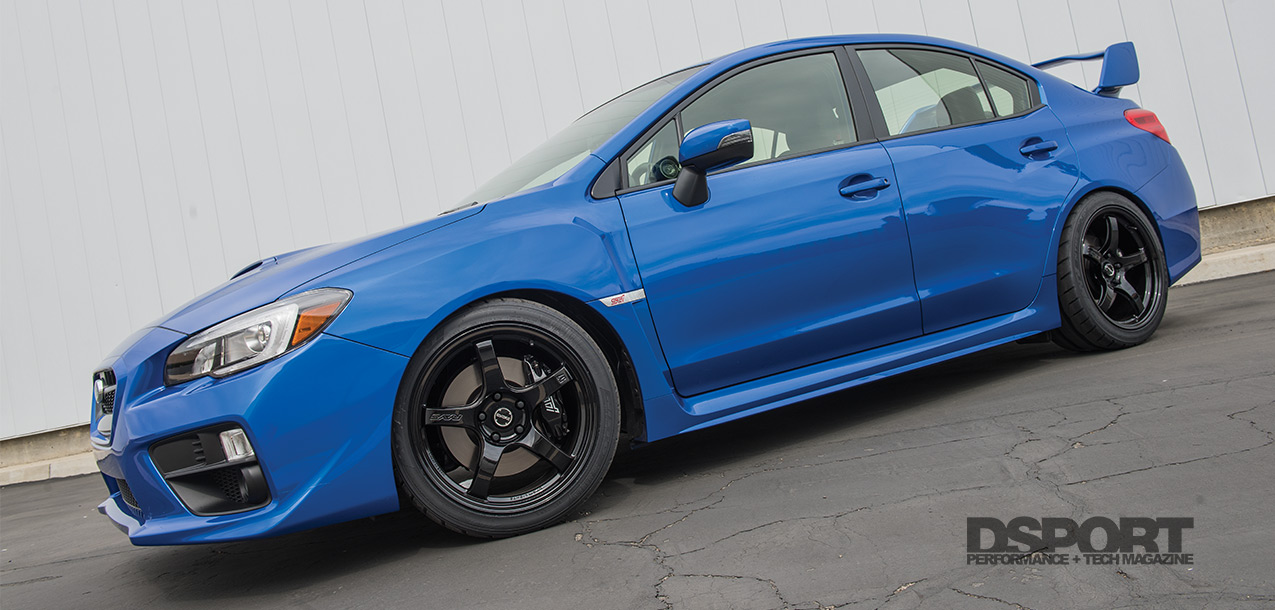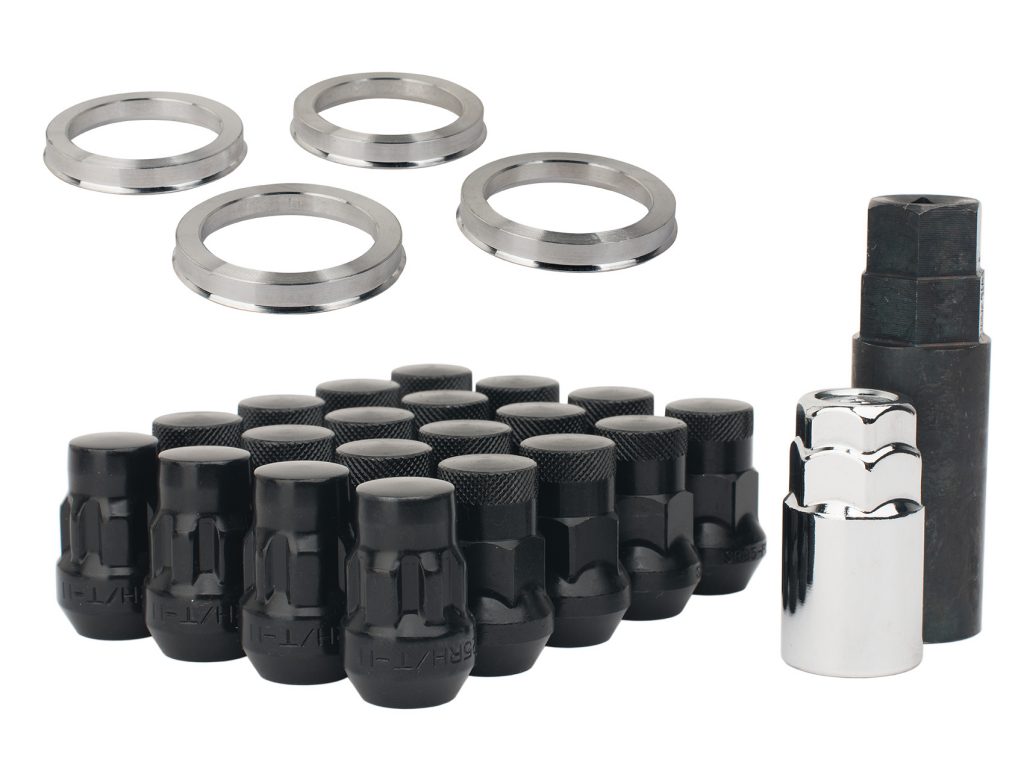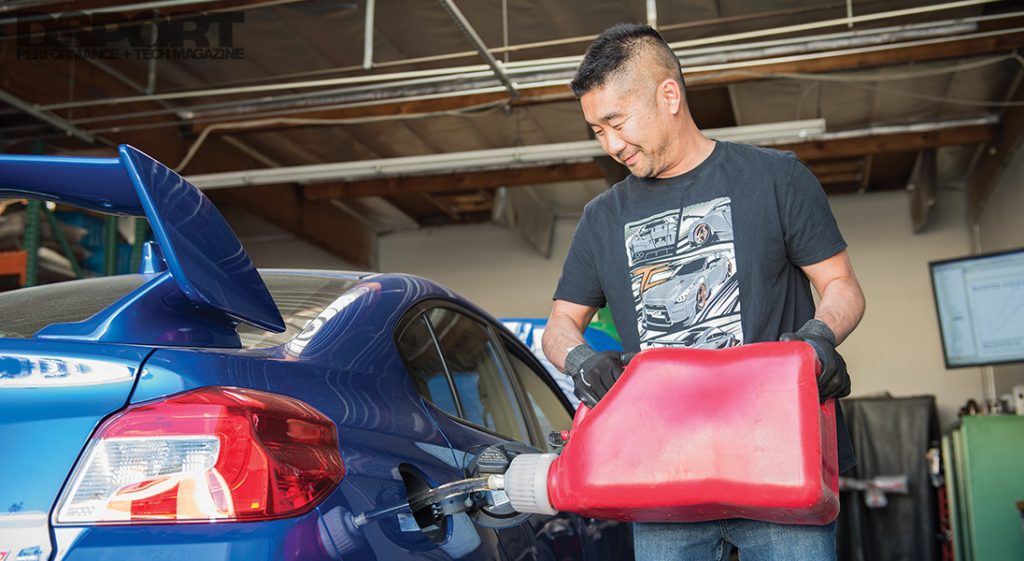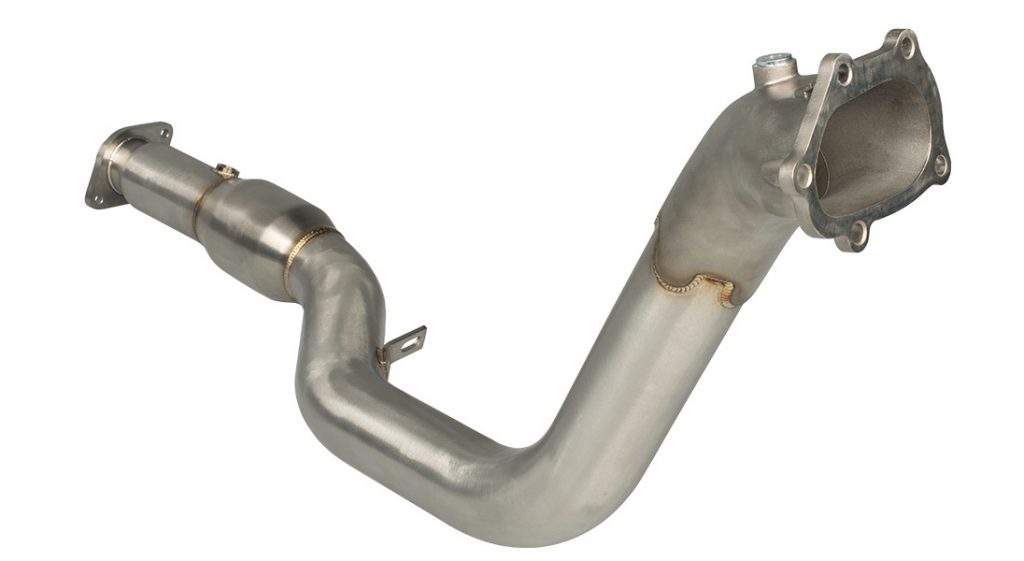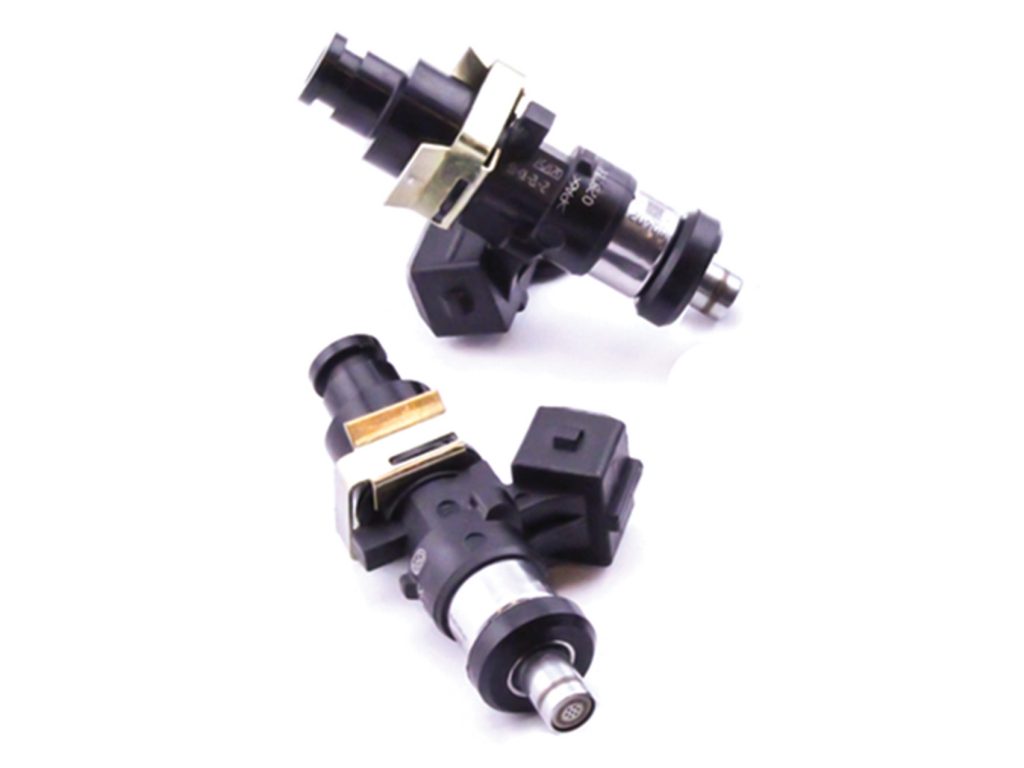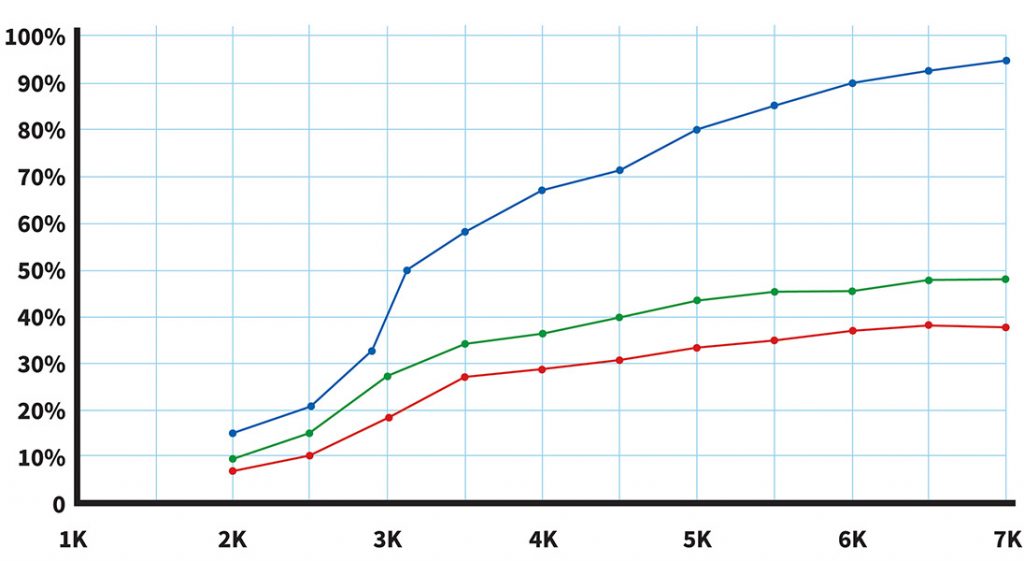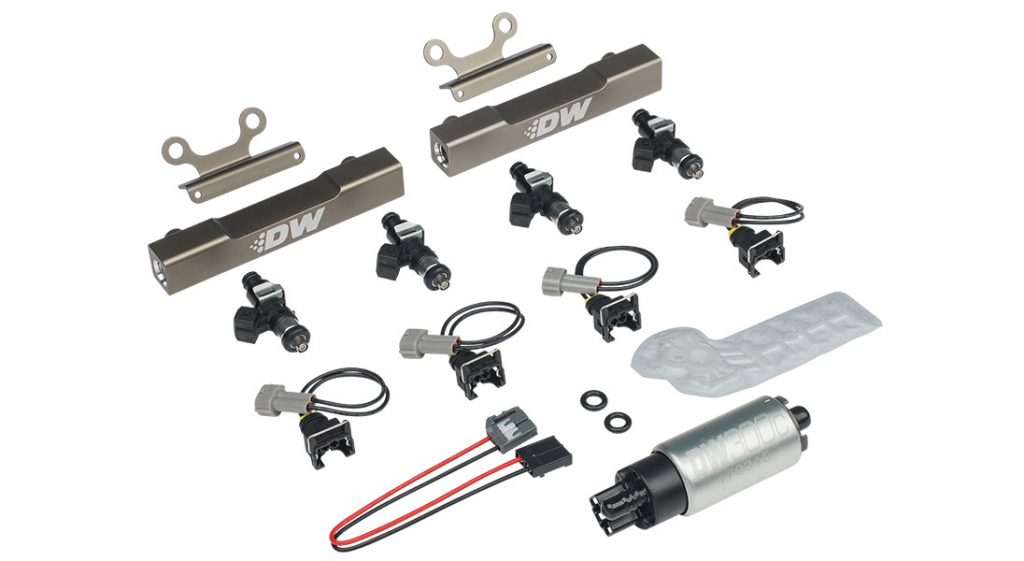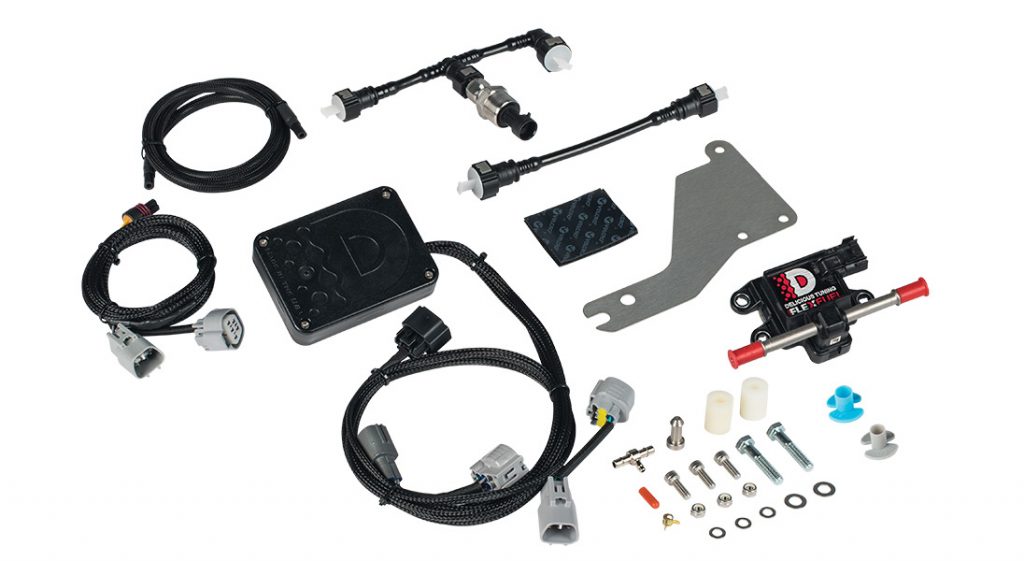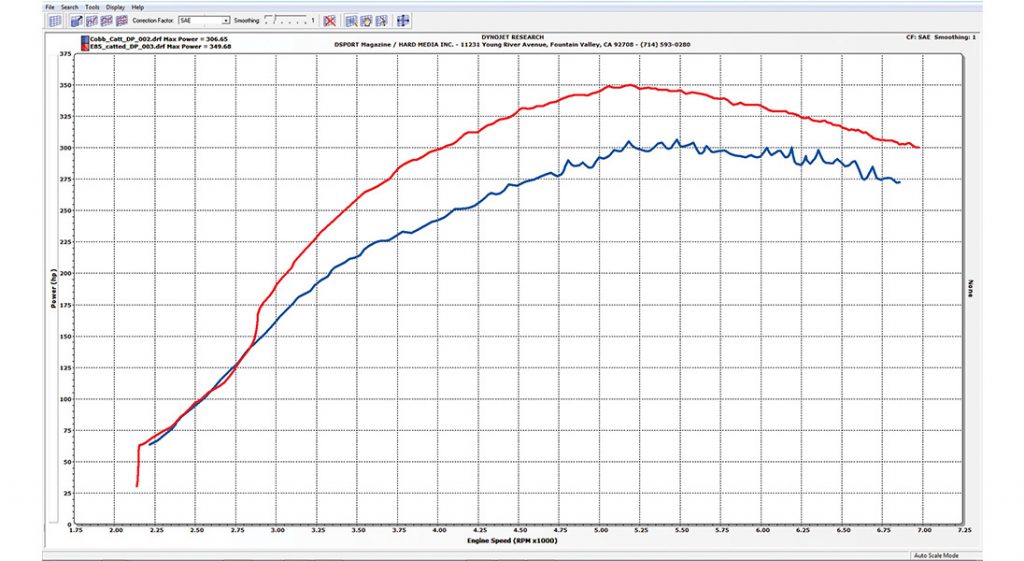Since the VAB Subaru WRX came to the market for the 2015 model year (check out DSPORT Issue #137) this platform has proven a favorite in the segment, especially by its loyal fanatics. DSPORT’s sales director Al Rhee recently joined this fraternity of loyalists when he purchased this 2017 WRX STI as his new daily driven family taxi. The beauty of this machine lay in the details, including its turbocharged EJ257 engine, all-wheel driveline and the VAB’s improved chassis stiffness (compared to the previous generation chassis).
Text by Richard Fong // Photos by Joe Singleton and Cameron Parsons // Testing by Al Rhee
DSPORT Issue #182
The D’Garage WRX STI
In DSPORT Issue #180, this STI was introduced as a D’Garage project vehicle. Baseline dyno pulls revealed a sharp dip in the torque curve and a slightly less than linear power curve. This prompted a recalibration of the ECU by Bill Knose of Delicious Tuning. Knose employed a COBB Accessport to interface with the factory ECU. Once optimized with just over 2.5psi additional boost pressure, the torque curve tapered off nicely from the peak and the power curve was much more linear. After installing a COBB Tuning SF Intake with air box, peak horsepower increased by just shy of five, while peak torque remained largely unchanged. Altogether, the Delicious Tuning calibration of the Accessport and the SF Intake yielded increases of 16.78 peak horsepower and 26.9 lb-ft peak torque. Even more impressive were the peak incremental gains of 36.93 whp and 50.7 lb-ft torque, which translated into much more usable power.
A Track Enthusiast Build
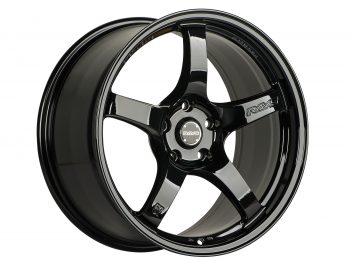 Al’s intent was to build his new STI to not only make more power for the daily commute and to shuttle his family around, it also needed to handle well for weekend jaunts to the track. Just as many OEMs design and equip various aspects of their vehicle products as a compromise between cost and performance, Subaru set up the STI to be more than competent for street driving and weekend track duty. However, that’s not to say that decent can’t be improved upon. The factory 18×8.5-inch aluminum rollers mounted with 245/40R18 Dunlop Sport Maxx RT summer tires to offer confident traction for daily driving with factory output. However, to increase the mechanical grip at each corner, Al elected to upgrade his rolling stock with a set of gloss black, 18×9.5-inch +38 offset Gram Lights 57CR wheels mounted with sticky Nitto NT05 tires in a 265/35R18 offering. The five spoke Gram Light wheels offer a wider barrel to accommodate the increased tread width of the NT05 rubber. The proven track performance of the NT05 along with the increased contact patch with the road lend to increasing the STI’s mechanical traction, which translates into putting more power to the ground in addition to improving lateral traction through the turns.
Al’s intent was to build his new STI to not only make more power for the daily commute and to shuttle his family around, it also needed to handle well for weekend jaunts to the track. Just as many OEMs design and equip various aspects of their vehicle products as a compromise between cost and performance, Subaru set up the STI to be more than competent for street driving and weekend track duty. However, that’s not to say that decent can’t be improved upon. The factory 18×8.5-inch aluminum rollers mounted with 245/40R18 Dunlop Sport Maxx RT summer tires to offer confident traction for daily driving with factory output. However, to increase the mechanical grip at each corner, Al elected to upgrade his rolling stock with a set of gloss black, 18×9.5-inch +38 offset Gram Lights 57CR wheels mounted with sticky Nitto NT05 tires in a 265/35R18 offering. The five spoke Gram Light wheels offer a wider barrel to accommodate the increased tread width of the NT05 rubber. The proven track performance of the NT05 along with the increased contact patch with the road lend to increasing the STI’s mechanical traction, which translates into putting more power to the ground in addition to improving lateral traction through the turns.
Muteki SR35 Lug Nuts and Hub Rings mount the Gram Lights 57CR wheels in place. The lugs are made from chrome vanadium to save on weight while retaining strength.
Roll Reduction
Increasing the STI’s traction advantage with wider, stickier tires amplifies the limitations of the factory spring and strut suspension, particularly in the way of ride height and body roll. To close the relatively tall gap and reduce the perceived body roll, we turned to Bilstein for a suspension solution. Bilstein has been in the business of suspension for quite a while, with a heritage that started in 1873. Designed and manufactured in Germany, its B16 9-way adjustable suspension offered just the features that Al wanted to facilitate a custom ride height, proper corner balancing and damper adjustments for both compression and rebound. Bilstein applies its proprietary Triple-C Technology ® exterior finish to the damper body for corrosion resistance. Specially rounded threads permit easy adjustment of the aluminum spring perches with a maximum height adjustment range of 20mm. Drawing on its lengthy and extensive racing heritage the gas-pressurized monotube dampers feature specialized valving that Bilstein ride engineers optimized for both street comfort and extreme motorsports conditions.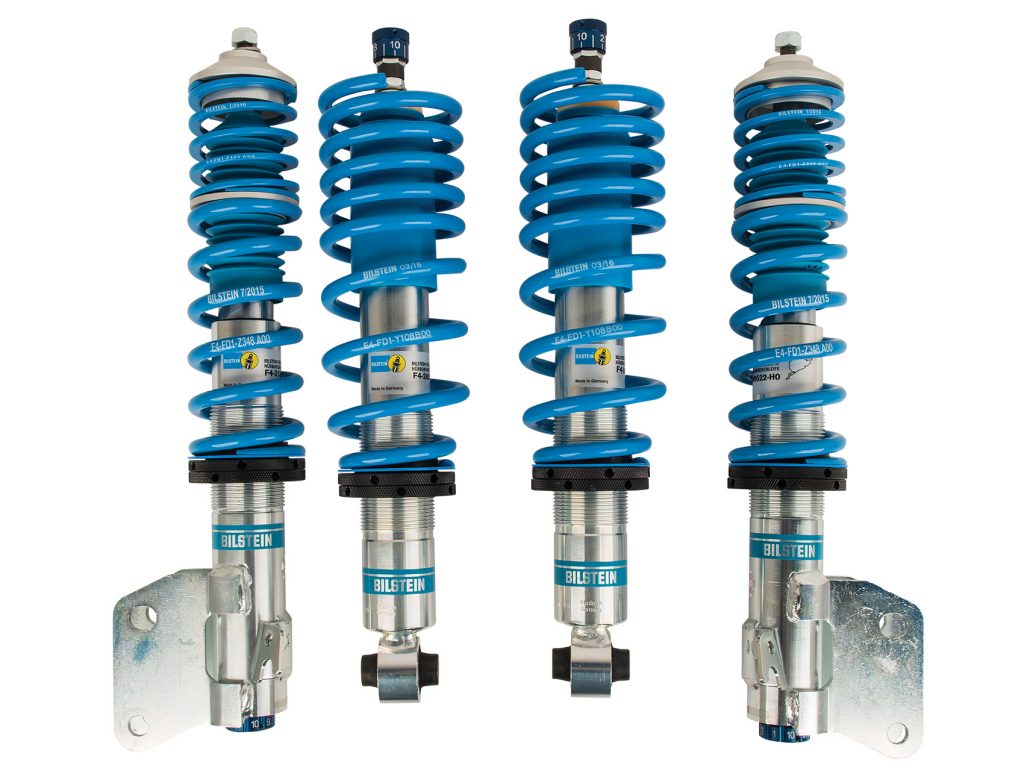
The Bilstein B16 manually adjustable damping monotube gas shock absorber provides precise suspension tuning with the turn of a dial.
Torture Tested
The dynamometer is both a testing and a tuning tool that offers consistent measurement of a vehicle’s output. In DSPORT Issue #181, DSPORT presented its most comprehensive product showcase to date, the WRX STI Exhaust Showcase. In this editorial, this STI served as the test mule as 12 different exhaust systems were evaluated across a myriad of categories. The COBB Tuning 3-inch cat-back exhaust increased the STI’s peak output to 283.74 horsepower and 299.8 lb-ft torque. It offered modest peak horsepower gains in exchange for more torque, a better overall power curve and superior midrange output with incremental gains on the order of 20.22 whp and 26.55 lb-ft torque. The exhaust tone was pleasing, offering little in the way of droning with sound levels that never exceeded 90dB. Emphasizing daily-drivability as the main priority, this exhaust complemented the STI and was the best fit for Al’s objectives. Thus, for this Test & Tune, we will continue testing using its dyno figures as the baseline for this round. After the first Test & Tune installment and the Exhaust Showcase, this STI has benefitted from the most basic of upgrades that enthusiasts would typically start with. The intake, exhaust and reflash increased peak horsepower by more than 19 whp and torque by 37 lb-ft.
The Parts
Turbocharged engines perform optimally in the absence of restriction. Therefore, a higher flowing intake and an easier breathing exhaust make such a wonderful difference on the dyno. Continuing down the path of reducing restrictions in and out of the EJ257 engine, the only exhaust component that hadn’t been upgraded was the downpipe. The factory downpipe includes an in-line catalytic converter which could pose a restriction in the exhaust path. Looking to COBB Tuning for a solution, we elected to test its catted downpipe. Constructed from corrosion-resistant T304 stainless steel, the COBB Tuning downpipe features a broad, CAD designed bell mouth at the turbo side that permits a smooth and unrestricted transition for the exhaust and the internal wastegate to dump into a 3-inch pipe that includes a high-flow catalytic converter. According to COBB Tuning, its 400-grade stainless-steel metal substrate outflows and outlasts the typical ceramic or “brick” style catalytic converters, making it an ideal stock replacement downpipe.
Knose commented that after calibrating the STI with the intake and exhaust, the factory fuel delivery system was already nearing its limits, reaching 94-percent peak duty cycle at 17psi with 91-octane fuel in the tank. Al also wanted to take advantage of the performance benefits that E85 offers. However, E85 typically demands 40-percent more fuel delivery than standard gasoline, so a significant increase in fuel supply would be in order. Also, due to its hydrophilic properties, the new fuel delivery components would have to be E85 compatible to function reliably. This prompted the search for an upgrade from the factory 550cc/min injectors and fuel pump. DeatschWerks’ Subaru Top Feed Fuel Rail Upgrade Kit with 1,500cc/min injectors along with its DW300c compact fuel pump presented a fuel system upgrade package that could provide ample fuel delivery for the EJ257’s bolt-on upgrades as well as future modifications.
With an E85 capable fuel delivery, it made sense to give in to the performance allure of E85 and the convenience of flex fuel capabilities. We decided to once again call upon Knose for his Delicious Tuning Flex Fuel Kit. Knose recently finished the development of his Flex Fuel Kit for the 2015+ Subaru VAB platform (both the WRX and the STI). Designed to interface with the factory ECU and the Cobb Accessport, the Delicious Tuning Flex Fuel kit includes an ethanol content analyzer in addition to the Delicious Tuning module. Unlike dual map systems that require actively swapping between calibration maps whenever changing over from one type of fuel to another, the Flex Fuel kit automatically adjusts the fuel delivery and ignition timing according to the ethanol contents. This ensures no confusion as to which maps are loaded, whether the fuel tank contains pure gasoline or pure E85 or a mixture of the two and, it’s simply convenient. Platforms that are not supported by Flex Fuel Kits typically must switch over to a stand-alone engine management system capable of supporting additional sensors and tables to enjoy the benefits of Flex Fuel.
High Flow vs. Catless
(L) Invidia Cat-Delete (R) Cobb High-Flow Cat
Turbocharged engines typically function more efficiently when permitted to breathe easier, which is usually why upgrading the intake and exhaust on a turbocharged vehicle yields telling details about specific aftermarket parts and the stock components that they replace. In the case of street vehicles, the factory catalytic converter(s) usually impede the flow of exhaust leaving the turbocharger(s), imposing a restriction on the exhaust flow and inhibiting power production. However, they are a necessary pollution control device on streetcars. In the case of off-road only vehicles, deleting the catalytic converter could yield additional horsepower gains. We decided to try the Invidia catalytic-delete test pipe on the STI to see if it would make a meaningful difference on the dyno. After investing the time to remove the COBB Tuning downpipe and replace it with the Invidia test pipe. On the dyno, the test pipe produced greater peak output figures (311.19 whp, 326.9 lb-ft). Interestingly, that’s an increase of 4.54 whp and 0.97 lb-ft torque. Considering that the test pipe offers no restriction at all, the COBB Tuning high-flow catalyst downpipe performs admirably.
DeatschWerks Flow vs Duty Cycle
While the factory injectors exceeded the threshold for maximum recommended injector duty cycle at 90 percent, the DeatschWerks 1,500cc injectors performed safely within the margins with plenty of room for growth.
The Dyno
Swapping out the factory downpipe in favor of the COBB Tuning downpipe required a little preparation, including removal of the heat shield around the turbocharger and spraying the bolts around the turbo flange and at the exhaust flange with WD-40 or any other similar lubricant. Once the bolts were broken loose above, just two bolts below at the exhaust flange facilitated the disconnection of the downpipe from the exhaust system. The handsomely finished downpipe features TIG welded joints, O2 sensor bungs and a polished surface that exudes refinement. Once the STI was strapped back onto DSPORT’s AWD Dynojet 424xLC2 Linx Dynamometer, the STI spun the rollers to the tune of 306.65 whp and 325 lb-ft torque. That’s an increase of 22.91 whp and 26.13 lb-ft torque. This demonstrates the amount of restriction that the factory catalyst poses compared to a high-flow catalyst.
Test 1: COBB Tuning Downpipe
306.65 WHP @ 5,450 RPM, 325.93 lb-ft @ 3,600 RPM, Boost @ 17 psi
The Cobb Tuning downpipe freed up an additional 22.91whp and 26.13 lb-ft of torque. The gains were consistent across the entire power band, and were very noticeable when driving.
When the fuel injectors are running at over 85-percent duty cycle, they are opened practically all the way under load. This is not a safe condition as a lean moment could occur and result in engine damaging detonation, especially if the engine is at wide open throttle under boost. The DeatschWerks Top Feed Fuel Rail Kit with 1,500cc/min injectors include all the necessary hardware for installation on the EJ257’s intake manifold ports. The billet aluminum fuel rails feature a larger bore and -6AN fittings for fuel feed and return. This design ensures that more than adequate fuel reaches the injectors, minimizing the potential for fuel starvation. However, these rails are not compatible with the stock fuel supply lines and require the conversion to -6AN feed and return lines. For this Test & Tune, the factory fuel rails were reused in order to complete the testing, as we will be running well below the maximum capacity of the injectors for this issue. (Al will redo his fuel delivery system to incorporate -6AN fuel lines to mate with the DeatschWerks rails in a future editorial.) The DeatschWerks 1,500cc/min injectors were a direct replacement for the factory 550cc/min injectors and installed seamlessly. The same could be said for the DeatschWerks DW300c compact fuel pump. Capable of 340lph flow rates, this E85 compatible fuel pump ensures a steady supply to the thirsty new injectors. Once Knose made adjustments in the COBB Tuning software for injector latency and rescaled for the higher flowing injectors, the STI was ready for calibration on the dyno. No longer relying on the stock injectors struggling to deliver fuel, the STI functioned more easily, with injector duty cycle down from 94-percent to a more comfortable 35-percent.
The DeatschWerks Fuel Rail Upgrade Kit w/ 1,500cc Injectors opens the door for the fuel demands of extra power. We upgraded the pump and injectors for this Test & Tune, with plans to install the rails in the future.
Now that the fuel delivery was up to the task of supporting the volumetric demands of E85, Knose installed his Delicious Tuning Flex Fuel kit on the STI. Having developed his Flex Fuel Kit for numerous and popular platforms, the Delicious Tuning Flex Fuel Kit functions seamlessly and automatically with any mixture of gasoline to E85 that the end user might have in the tank. In under an hour, the Delicious Tuning flex fuel system was installed with the ethanol content analyzer in-line with the fuel delivery system to ensure accurate reporting of the fuel mixture entering the rails. With a full tank of E85 at his disposal, Knose calibrated the ECU for a higher boost level (21psi), increasing the injector duty cycle and adjusting the ignition timing accordingly. Output jumped to a peak of 349.68 whp and 397.29 lb-ft torque, an increase of 43.03 horsepower and 71.36 lb-ft torque compared to the previous tune on 91 octane fuel.
The Delicious Tuning 08-17 STI Flex Fuel Kit MK2 for Cobb is designed for seamless compatibility with the Cobb Accessport V3. It even features Bluetooth functionality to monitor parameters on your phone.
The Bottom Line
The addition of the downpipe along with the fuel delivery upgrades and the flex fuel conversion paid impressive dividends in the form of 65.94 additional horsepower and 97.49 lb-ft of extra torque compared to the baseline figures. That’s 23-percent more horsepower and 34-percent additional torque, which translates into unmistakable improvements in output when sitting behind the wheel. The COBB Tuning downpipe with high flow catalytic converter demonstrated that there was certainly some restriction in the factory downpipe that could hamper power production. We also learned that after testing the Invidia catless downpipe, the COBB Tuning downpipe was almost as free flowing as a test pipe. The test pipe only increased horsepower by 4.54 and torque by 0.97 lb-ft.
After the first Test & Tune, it was noted that injector duty cycles were up at 94-percent at 17psi boost pressure, a sign that the fuel delivery had already been maxed out. After upgrading with a set of DeatschWerks 1,500cc/min injectors backed by a 340lph DeatschWerks DW300c fuel pump, duty cycles dropped to only 34 percent at the same level of output, a much safer and more consistent range to function within. With the increased fuel delivery capacity of the DeatschWerks injectors and pump, making the jump to E85 and Flex Fuel proved seamless. After installing the Delicious Tuning Flex Fuel Kit and calibrating with E85, we witnessed the performance potential in ethanol. Employing more aggressive timing, increasing fuel delivery and bumping the boost pressure by only 3psi, the STI put down an additional 43.03 whp and 71.36 lb-ft torque. This translates into g-force inducing acceleration that can be felt in any gear. We noticed that injector duty cycle was at approximately 47.6-percent, which leaves a lot of room for growth and further modifications.
This combination of upgrades really woke up the STI with a completely different driving characteristic than before, especially with the rise in bottom-end torque.
In the next Test & Tune installment, we push the STI even harder, upgrading to a front-mount intercooler for improved cooling of the intake charge, along with a turbo manifold upgrade and a sport turbocharger upgrade. Stay tuned.
| Test Results | HP Level | HP Increasel | % Increase | Total |
|---|---|---|---|---|
| BASELINE | 283.74 WHP | – | – | – |
| Test 1: Cobb Tuning 3-inch Downpipe | 306.65 WHP | 22.91 | 8.1 | 22.91 |
| Test 2: Delicious Tuning Flex Fuel Kit | 349.68 WHP | 43.03 | 14.0 | 65.94 |
| * * * * * | ||||
| Final Power | 349.68 WHP | – | 23.24 | 65.94 |
| Parts Price List | ||||
|---|---|---|---|---|
| Cobb Tuning 3-Inch Stainless Steel Downpipe (p/n 524203) | $595.00 | |||
| DeatschWerks Fuel Rail Upgrade Kit w/1,500cc/min Injectors (p/n 6-102-1500) | $949.00 | |||
| DeatschWerks DW300C Fuel Pump (p/n 9-309-1008) | $189.00 | |||
| Delicious Tuning Subaru VAB Flex Fuel Kit for Cobb Accessport | $695.00 | |||
| * * * * * | ||||
| Total MSRP | $2,428.00 | |||
| DSPORT Street Price | $2,063 – $2,185.20 | |||


